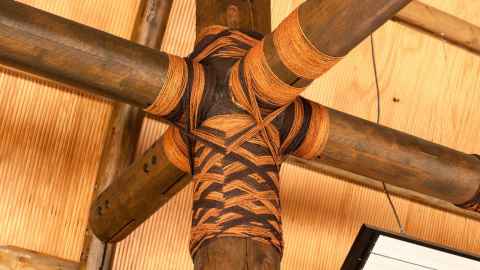Lalava Residency
The artist is back to complete his work. At the same time he is working to acquaint young people with the mysteries of the links between past and present, through the ancient Pacific art of sennit lashing, used in the construction of canoes and houses, and of the University’s own Fale Pasifika.
Sopolomelama Filipe Tohi, a Tufunga Lalava or master craftsman, created the bindings seen on the massive beams in the ceiling of the fale. Now, nine years after the grand, formal opening of the building which forms the traditional heart of the Centre for Pacific Studies, Filipe has returned as the Fale Pasifika Heritage Artist in Residence to extend and complete his work. Throughout the month of June he will be creating new bindings for the uncovered joints at the side of the ceiling, one of which can be seen in the photo above.
Filipe was born in Ngele’ia, Nuku’alofa, Tonga, and immigrated to New Zealand in 1988. He has completed several commissioned artworks for public buildings, including a sculpture that stands in front of the Auckland Art Gallery. He was bestowed with the title of Sopolomelama or “bringer of light” by the Samoan head of state in 2004 for his lashing on a fale near Apia in Samoa.
Filipe is the fourth artist to join the Heritage Artist in Residence Programme, which established the Fale Pasifika as a dedicated site to encourage preservation of traditional knowledge through heritage art forms.
For his work in the fale Filipe is using long lengths of sennit made from the husks of coconuts, which are dyed in the traditional red and black, then wound and tied to create distinctive geometric patterns.The colours are symbolic, as Filipe explains. The red represents the male and the black the female, linking back to legends of the tree of life - the coconut - which provides food, drink, medicine, materials for building, for constructing canoes and tattooing tools, and for making fishing nets.
The traditional patterns of sennit, complex and many-layered, are “like a language. When you unravel the patterns, you show the symbols that express knowledge that is meaningful in the culture.”
There was no written language so the patterns, with their thousands of variations, give insights into the history of the Pacific people and the environment in which they lived.

“Just as the string binds the canoe and makes it strong, it also provides a link to the past, binding people together. The sennit is a symbol of genealogy, like the umbilical cord that links succeeding generations and connects us with our ancestors. You can feel the past at the same time you see the present.”
Filipe feels it is vital in the University for young people to have some glimpse of the past. “The residency is important to me because this is the institution where people begin to question who they are and where they are going.”
It is for the young people also that Filipe is continually extending the range of his craft, embracing new techniques and using non-traditional materials such as steel, aluminium and wood. “I have to develop different techniques so young people can see that they have a relationship with this kind of art form, and can play a part in taking it into the future.”